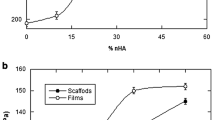Abstract
The effect of the physical structure and chemical modification of poly(glycol monomethacrylate) gels on the calcification of test implants has been studied. While the chemical modification of the poly(glycol monomethacrylate) backbone by the introduction of ionogenic groups did not affect the process of calcification, there was a substantial effect of the physical structure of the polymer, as determined by the monomer: water ratio, on the process of calcification of the implants. Homogenous and microporous gels showed calcification in the margin of the implant only exceptionally; in macroporous gels calcification occurred massively in the margin of the implant and in the case of a higher porosity in its centre. This phenomenon has been explained by the different degree to which the implant is penetrated by the newly formed tissue, as well as by the difference in accessibility of nutrition to the penetrating cells depending on the porosity of the implant.
Abstract
L'effet de la structure physique et des modification chimiques de gels de poly(glycol monométhacrylate) sur la calcification d'implants tests a été étudié. Alors que les modifications chimiques du poly(glycol monométhacrylate) osseux, obtenu par introduction de groupes formateurs d'ions, n'affectent pas le processus de calcification, on observe un effet net de la structure physique du polymère par action du rapport monomère: eau sur le processus de calcification des implants. Des gels homogènes et microporeux montrent rarement une calcification autor de l'implant; dans les gels macroporeux, la calcification s'observe massivement autour de l'implant, en cas de porosité élevée en son centre. Ce phénomène a été expliqué par la pénétration diverse par du tissu néoformé ainsi que par la possibilité de pénétration d'éléments nutritifs cellulaires, liée à la porosité de l'implant.
Zusammenfassung
Die Wirkung der physikalischen Struktur und der chemischen Veränderung von Poly-(Glycol-Monomethacrylat)-Gelen auf die Verkalkung von Implantat-Proben wurde untersucht. Die chemische Veränderung der Poly(Glycol-Monomethacrylat)-Grundstruktur, hervorgerufen durch das Beifügen ionogener Gruppen, hatte auf den Verkalkungsprozeß keine Wirkung; die physikalische Struktur des Polymers hingegen hatte eine markante Wirkung auf den Verkalkungsprozeß der Implantate, welche durch das Verhältnis Monomer: Wasser bestimmt wurde. Homogene und kleinporöse Gele zeigten ganz ausnahmsweise eine Verkalkung am Rande des Implantats; in großporösen Gelen erfolgte massive Verkalkung am Rande des Implantats, bei höherer Porosität in dessen Zentrum. Dieses Phänomen wird zurückgeführt auf den unterschiedlichen Grad, in welchem das neu gebildete Gewebe das Implantat durchdringt und auf die verschiedene Zugänglichkeit der Nahrung der eindringenden Zellen, welche von der Porosität des Implantats abhängt.
Similar content being viewed by others
References
Barvič, M.: Reaction of the organism ot the presence of acrylate implants and their carcinogenic properties [in Czech]. Acta Univ. Carol. Med. (Praha)8, 707–749 (1962)
Barvič, M., Kliment, K., Zavadil, M.: Biological properties of sponge-like polymers of ethyleneglycol methacrylate gels and the possibilities of their practical application. J. biomed. Mater. Res.1, 313–323 (1967)
Černý, E., Chromeček, R., Opletal, A., Papoušek, F., Otoupalová, J.: Tissue reaction in laboratory animals to some varieties of glycol methacrylate polymers. Scripta Medica43, 63–75 (1970)
Činátl, J., Šprincl, L., Kouřílek, K.: Calcification of cell nuclei in experimental necrosisin vivo. Nature (Lond.)216, 1011–1013 (1967)
Gore, I., Arons, W.: Calcification of the myocardium. Arch. Path.48, 1–12 (1949)
Hepler, O. E., Simonds, J. P.: Experimental nephropathies. Arch. Path.40, 37–43 (1945)
Hubáček, J., Tesařík, J.: Artificial stapes in tympanoplastic operations [in Czech.]. Čs. Otolaryng.13, 13–20 (1964)
Kopeček, J., Jokl, J., Lím, D.: Mechanism of the three-dimensional polymerization of glycol methacrylates [in German]. J. Polymer Sci. C16, 3877–3889 (1968)
Kopeček, J., Vacík, J., Lím, D.: Permeability of membranes containing ionogenic groups. J. Polymer Sci. A-1,9, 2801–2815 (1971)
Kopeček, J., Lím, D.: Mechanism of the three-dimensional polymerization of glycol methacrylates. II. System glycol monomethacrylate-glycol dimethacrylates-solvents. J. Polymer Sci. A-1,9, 147–154 (1971)
Křístek, A., König, B., Wichterle, O.: Contribution to the surgery of retinal detachment. Čs. Oftal.22, 58–61 (1966)
Šmahel, J., Moserová, J., Běhounková, E.: Histological processes following implantation of porous hydrophilic gel [in Czech.]. Rozhl. Chir.50, 572–576 (1971)
Šprincl, L., Kopeček, J., Lím, D.: Effect of porosity of heterogeneous poly(glycol monomethacrylate) gels on the healing-in of test implants. J. biomed. Mater. Res.5, 447–458 (1971)
Author information
Authors and Affiliations
Rights and permissions
About this article
Cite this article
Šprincl, L., Kopeček, J. & Lím, D. Effect of the structure of poly(glycol monomethacrylate) gel on the calcification of implants. Calc. Tis Res. 13, 63–72 (1973). https://doi.org/10.1007/BF02015397
Received:
Accepted:
Issue Date:
DOI: https://doi.org/10.1007/BF02015397




